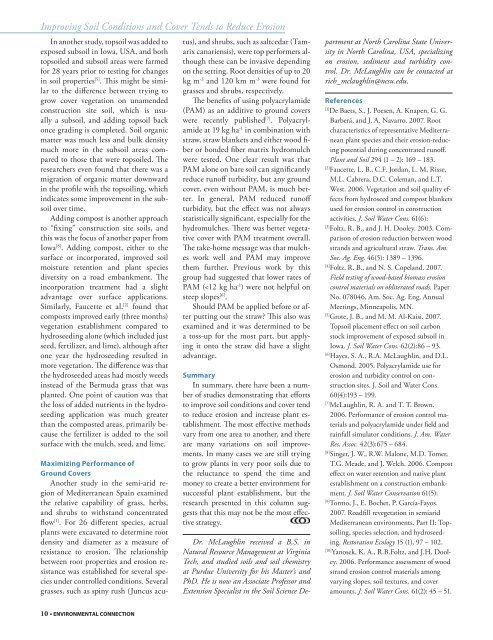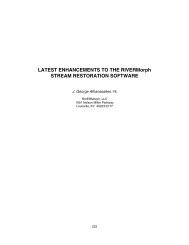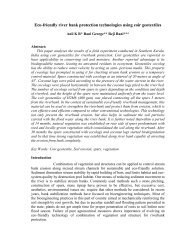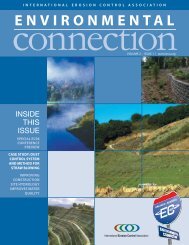ENVIRONMENTAL - International Erosion Control Association
ENVIRONMENTAL - International Erosion Control Association
ENVIRONMENTAL - International Erosion Control Association
Create successful ePaper yourself
Turn your PDF publications into a flip-book with our unique Google optimized e-Paper software.
Improving Soil Conditions and Cover Tends to Reduce <strong>Erosion</strong><br />
In another study, topsoil was added to<br />
exposed subsoil in Iowa, USA, and both<br />
topsoiled and subsoil areas were farmed<br />
for 28 years prior to testing for changes<br />
in soil properties [5] . This might be similar<br />
to the difference between trying to<br />
grow cover vegetation on unamended<br />
construction site soil, which is usually<br />
a subsoil, and adding topsoil back<br />
once grading is completed. Soil organic<br />
matter was much less and bulk density<br />
much more in the subsoil areas compared<br />
to those that were topsoiled. The<br />
researchers even found that there was a<br />
migration of organic matter downward<br />
in the profi le with the topsoiling, which<br />
indicates some improvement in the subsoil<br />
over time.<br />
Adding compost is another approach<br />
to “fi xing” construction site soils, and<br />
this was the focus of another paper from<br />
Iowa [8] . Adding compost, either to the<br />
surface or incorporated, improved soil<br />
moisture retention and plant species<br />
diversity on a road embankment. The<br />
incorporation treatment had a slight<br />
advantage over surface applications.<br />
Similarly, Faucette et al. [2] found that<br />
composts improved early (three months)<br />
vegetation establishment compared to<br />
hydroseeding alone (which included just<br />
seed, fertilizer, and lime), although after<br />
one year the hydroseeding resulted in<br />
more vegetation. The difference was that<br />
the hydroseeded areas had mostly weeds<br />
instead of the Bermuda grass that was<br />
planted. One point of caution was that<br />
the loss of added nutrients in the hydroseeding<br />
application was much greater<br />
than the composted areas, primarily because<br />
the fertilizer is added to the soil<br />
surface with the mulch, seed, and lime.<br />
Maximizing Performance of<br />
Ground Covers<br />
Another study in the semi-arid region<br />
of Mediterranean Spain examined<br />
the relative capability of grass, herbs,<br />
and shrubs to withstand concentrated<br />
flow [1] . For 26 different species, actual<br />
plants were excavated to determine root<br />
density and diameter as a measure of<br />
resistance to erosion. The relationship<br />
between root properties and erosion resistance<br />
was established for several species<br />
under controlled conditions. Several<br />
grasses, such as spiny rush (Juncus acutus),<br />
and shrubs, such as saltcedar (Tamarix<br />
canariensis), were top performers although<br />
these can be invasive depending<br />
on the setting. Root densities of up to 20<br />
kg m -3 and 120 km m -3 were found for<br />
grasses and shrubs, respectively.<br />
The benefits of using polyacrylamide<br />
(PAM) as an additive to ground covers<br />
were recently published [7] . Polyacrylamide<br />
at 19 kg ha -1 in combination with<br />
straw, straw blankets and either wood fiber<br />
or bonded fiber matrix hydromulch<br />
were tested. One clear result was that<br />
PAM alone on bare soil can significantly<br />
reduce runoff turbidity, but any ground<br />
cover, even without PAM, is much better.<br />
In general, PAM reduced runoff<br />
turbidity, but the effect was not always<br />
statistically significant, especially for the<br />
hydromulches. There was better vegetative<br />
cover with PAM treatment overall.<br />
The take-home message was that mulches<br />
work well and PAM may improve<br />
them further. Previous work by this<br />
group had suggested that lower rates of<br />
PAM (













